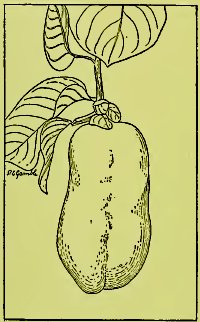The Giant Granadilla
Passiflora quadrangularis L.
While this is the largest-fruited species of the genus, and one of the most widely distributed, it is not the best in quality.
From
its native home in tropical America it has been carried to the eastern
tropics, where it is now grown in many places. It is common in the West
Indies, but nowhere is it cultivated on a commercial scale.
The
plant is somewhat coarse and is a strong climber. The stems are
four-angled, as indicated by the specific name, and the leaves are
ovate or roundovate, cordate at the base and mucronate at the apex,
entire, and 6 or 8 inches long. The flowers, which are about 3 inches
in diameter, are white and purple in color. The fruits are oblong, up
to 10 inches in length. H. F. Macmillan says: "Its large, oblong,
greenish-yellow fruit is not unlike a short and thick vegetable-marrow,
and contains in its hollow center a mass of purple, sweet-acid pulp
mixed with flat seeds." A horticultural form exists which has leaves
variegated with yellow.
This species is more tropical in its requirements than P. ligularis and P. edulis.
It will grow in southern Florida, but is not successful in California.
A. Robertson-Proschowsky reports, however, that it has fruited on the
French Riviera at Golfe-Juan and perhaps elsewhere, and in his own
garden at Nice was only killed after surviving several winters.
The
fruit is known in French as barbadine, in Portuguese as maracujd melao,
and in Spanish as granadilla or granadilla real. The name granadilla is
applied, in different parts of the tropics, to several species of Passiflora,
and in order to distinguish them it is necessary to append a qualifying
word. It is derived from granada, and means "small pomegranate."
Macmillan recommends that the shoots be well cut back after the
fruiting season is past. It is commonly believed necessary to resort to
hand-pollination to insure the production of fruit, but this is not
always the case. The protandrous character of the passifloras, and the
necessity of cross-pollination, are mentioned in the discussion of the
purple granadilla that it is sometimes possible, however, for fruits to
be produced by self-fertilization, has been shown by experience. Paul
Knuth, after describing the character of the passiflora flower, says:
"Autogamy (self-pollination) would seem to be etcluded under such
circumstances, yet it is possible that the stigmas and the anthers may
be brought into contact when the flower closes at the end of the single
day's anthesis. This is the more probable as Warnstorf saw a fully
formed fruit in a greenhouse. Here, then, is a case in which an
obviously chasmogamous flower (one in which the perianth opens) is only
self-pollinated after it has closed." If P. quadrangularis is
self-sterile, however, it would do no good to have the flowers
self-pollinated. If insects are lacking to do the work,
crosspollination must be effected by hand.
Propagation is by
seed or by cuttings, which should be 10 to 12 inches long and from
well-matured stems, and should be inserted in sand.
Several other species of Passiflora are cultivated in the tropics for their fruit. P. laurifolia,
known as yellow granadilla, waterlemon, Jamaica honeysuckle, sweet-cup,
bell-apple, and pomme d'or, is cultivated in the West Indies, and to a
limited extent in other regions. H. F. Maemillan states that it is not
fruitful in the eastern tropics, P. maliformis, L. is grown in the West Indies, and in the mountains of Colombia, where it is called curuba or kuruba.

Fig. 31. The giant granadilla
(Passiflora quadrangularis). (X 1/2)
Back to
Giant Granadilla Page
|